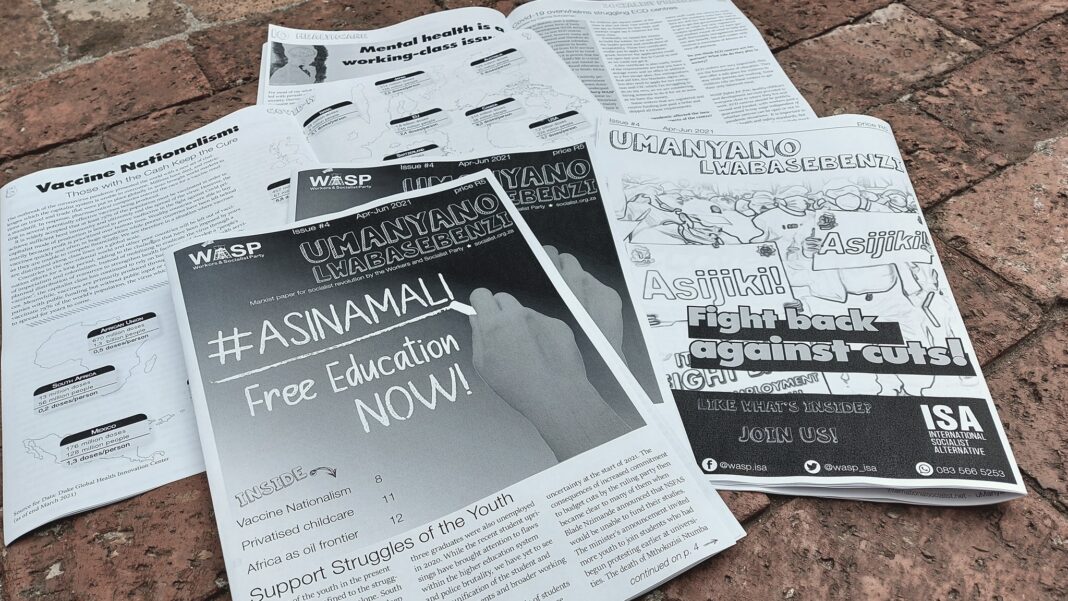The following is featured in our April – June 2021 uManyano lwaBasebenzi publication
Dear Reader,
In March student protests swept across the country yet again. Students embarked on protests against budget cuts to higher education, financial and academic exclusions, and for cancellation of R13 billion historic student debt and quality, free public education. Austerity cuts of R9 billion from the allocation to higher education, combined with an explosive increase in the number of students applying for NSFAS, triggered the wave of protests. Due to massive losses of income in 2020 from the C19 pandemic lockdowns and the slump in the economy, applications for NSFAS increased by 25%, adding 185 000 more students than last year.
This movement is an important milestone in the resurgence of student resistance to the savage attacks on education by the ANC government. The bold demands to cancel historic student debt and for free education meant the movement started on a higher political plane than FMF in 2015. The main challenge for a future mass movement on the scale of FMF is forging a programme that can win and mobilise masses of students not currently involved. This would mean overcoming sectarianism and opportunism of the PYA and EFFSC, which only deepen divisions and weaken the movement. Whilst we support calls for unity, we also believe that it will not be achieved through ‘talks’ between leaders of PYA, EFFSC and PASMA, who align with capitalist parties. The struggle of the students across universities and TVET colleges must be put firmly on a working class foundation, with a serious commitment to ensure democratic discussions and mass assemblies to build a programme on the way forward for students.
The deepening crisis of capitalism clearly shows that access to education at all levels can only be won as a right for all, or lost as a privilege for some. We have to urgently build a revolutionary Socialist Youth Movement to fight for real change in these institutions, to win free education NOW. But, it must also turn to and aim to organise amongst it the 3.5 million young people who are ‘Not in Employment, Education and Training’ (NEETs). Its ranks must be filled with young workers who are facing increasing job insecurity, high debt and poverty wages.
Public sector workers are facing wage and staff cuts of over R300 billion in the next three years. The government’s criminal wrecking of the public sector wage agreement sets a dangerous precedent for the private sector bosses to answer the call of a race to the bottom in wages, in addition to the relentless jobs bloodbath taking place. At the same time communities have been devastated by the pandemic with massive losses of income and cuts in housing, healthcare and essential public services. Women have been disproportionately affected by job losses, as well as facing increasing Gender Based Violence as services are stripped to the bone.
The SAFTU general strike on February 24, provides ample insight of what is possible for the working class in the next period. Above all, it shows the work that needs to be done to escalate the struggle to a much higher level of working-class unity. There is no time to waste on inaction or half-hearted action.
The task of uniting and mobilising all the layers of the working class must be taken on with urgency and clarity. In this period, the capitalist system plunges to new depths of crises with each day, making evident its long-past expiry date. This is as true for South Africa, as it is across the world where mass mobilisations have taken place in spite of increasing repression. Our solidarity is with the millions of people in Myanmar currently mobilising and striking against the military coup staged on February 1. We condemn the brutality the military have responded with and mourn the loss of close to 500 civilians, including children, murdered by this regime.
We must unite worker, community, and youth struggles. With each manifestation of working class unity in action the alternative of socialism becomes ever more possible.

